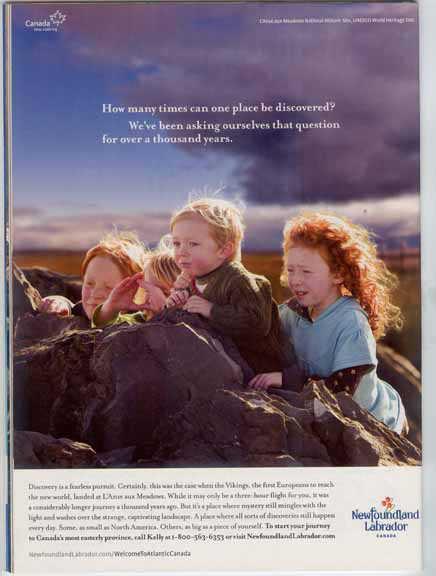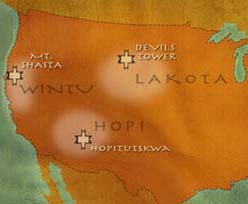
Discovery is a fearless pursuit. Certainly, this was the case when the Vikings, the first Europeans to reach the new world, landed at L’Anse aux Meadows. While it may only be a three-hour flight for you, it was a considerably longer journey a thousand years ago. But it’s a place where mystery still mingles with the light and washes over the strange, captivating landscape. A place where all sorts of discoveries still happen every day. Some, as small as North America. Others, as big as a piece of yourself.
This ad seems to encapsulate two of the ways that North America cleanses the story of its origin, refusing to acknowledge that our nations are founded on genocide.
The first: calling the Europeans’ arrival in the Americas “Discovery,” rather than Colonisation or Genocide. You can only call their arrival “discovery” if there weren’t any humans here who had already discovered the land. And if you think about, that’s the implication: it was a discovery, because the people who were already here were not considered human by the Europeans.
No thank you, Newfoundland.
This ignores all the Canadians who were and are indigenous. And it stupidly talks about discovering as if it were a continuous process. In fact, from before 1000 to maybe 1800, the majority of Canadians were indigenous. For 80% of the 1,000-year period, Natives were asking and answering most of the questions. For 80% of that time, they were making most of Canada's discoveries.
Also note the Aryan-style kids in the ad. Are these the people who are rediscovering Newfoundland? What about the blacks, Muslims, and other minorities in Europe? Can't they discover Newfoundland too? What about the tourists from Asia, Africa, and other continents? Maybe they'd like to discover Newfoundland as well.
This ad veers uncomfortably close to racism. White people discovered Newfoundland and continue to discover it. Newfoundland is a great place for white people. C'mon, all you WASPs! Blonds and redheads welcome, brunettes tolerated! (They're probably okay, but they may have a little of that "bad" Mediterranean blood.)
The "empty land" stereotype
Let's review how this warped thinking came about.
In some cases the European invaders literally claimed America was uninhabited. In other cases, they admitted it was inhabited by people, but only savages equivalent to animals. Animals can mark their territory but they can't own it.
In a few cases they admitted somebody had built great civilizations. But those people had vanished, leaving only the degenerate wretches known as Indians. These people were akin to squatters or pests occupying someone else's property. Again, they weren't its owners.
Hence the land was occupied but not owned. Hence the infamous "Doctrine of Discovery" and all it entailed. America (including Canada) was free for the taking.
For more examples of the "discovery" meme, see Empty Land in The Gift Outright and Hudson Bay Company Invented Cowichan Sweaters?! For a discussion of the Indians' legal title, see Indians Owned the United States.


5 comments:
What time period is that map supposed to represent?
Yes, but these are people who are not ashamed of who they are, or where they are from:
http://www.independent.co.uk/news/world/the-town-that-refuses-to-be-ashamed-of-its-name-1612234.html
The map symbolically represents the centuries since Leif Ericson's voyage to America. You know, the centuries in which "discovering" the continent was impossible because it was already inhabited.
As long as it not meant to be anything very old, let alone pre-Columbian.
The Lakota were not in the area on the map until relatively recently. When they "discovered" the Black Hills and Great Plains.
Yes, we know about the Lakota migrations. We don't need to rehash that subject again. ;-)
The map shows Devils Tower, which is revered by the Arapaho, Crow, Cheyenne, and Kiowa as well as the Lakota. And the Lakota don't have to originate in the Black Hills to consider the area sacred.
Post a Comment